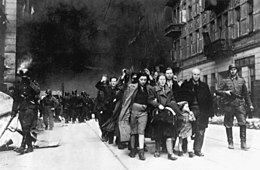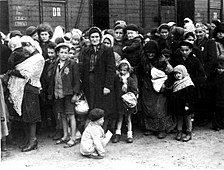Ghetto uprisings: Difference between revisions
m →See also: Updated entry re ghettos in Nazi-occupied Europe. |
|||
| Line 31: | Line 31: | ||
*[[Ghetto Fighters' House]] |
*[[Ghetto Fighters' House]] |
||
*[[Jewish response to The Forty Days of Musa Dagh]] |
*[[Jewish response to The Forty Days of Musa Dagh]] |
||
*[[Nazi gun control theory]] |
|||
==References== |
==References== |
||
Revision as of 09:22, 10 May 2015

Ghetto uprisings during World War II were the armed revolts by Jews and other prisoners incarcerated in the newly established ghettos in Nazi-occupied Europe after the German invasion of Poland in 1939, as well as its own ally the Soviet Union in 1941. In most instances, the ghetto resistance fighters took up arms against the Nazi plans to deport all inhabitants to concentration and extermination camps with the aim of their mass extermination.[1]
Armed resistance was offered in over 100 ghettos.[2] Some of these uprisings were more massive and organized, while others were small and spontaneous. The best known and the biggest of such uprisings took place in Warsaw in April–May 1943.[3] In the course of the Warsaw Ghetto Uprising 56,065 Jews were either killed on the spot or captured and transported aboard Holocaust trains to extermination camps before the Ghetto was razed to the ground, according Stroop Report.[4][5] There were also other such struggles leading to the wholesale burning of the ghettos.[6]
| Part of a series on |
| The Holocaust |
|---|
 |
Selected ghetto uprisings during the Holocaust
Notable instances included:[7]
- Będzin Ghetto Uprising also known as the Będzin-Sosnowiec Ghetto Uprising
- Białystok Ghetto Uprising - organized by the Antyfaszystowska Organizacja Bojowa
- Częstochowa Ghetto Uprising
- Łachwa (Lakhva) Ghetto Uprising
- Mińsk Mazowiecki Ghetto Retaliation action
- Warsaw Ghetto Uprising organised by the ŻOB and ŻZW
- Riga Ghetto Resistance movement
To some extent the armed struggle was also carried out during the final liquidation of the Ghettos in:
- Kraków Ghetto
- Łódź Ghetto
- Lwów Ghetto
- Marcinkonys Ghetto
- Minsk Ghetto
- Pińsk Ghetto
- Sosnowiec Ghetto
- Wilno (Vilna) Ghetto - resistance of the Fareinigte Partizaner Organizacje
See also
- Anti-fascism
- Ghettos in Nazi-occupied Europe
- Ghetto Fighters' House
- Jewish response to The Forty Days of Musa Dagh
- Nazi gun control theory
References
- ^ "Resistance in Ghettos". Jewish Uprisings in Ghettos and Camps, 1941–1944. Holocaust Encyclopedia. June 10, 2013. Retrieved 9 January 2014.
- ^ "Jewish Resistance". United States Holocaust Memorial Museum. 2011. Retrieved 9 January 2014.
- ^ "April–May 1943, Warsaw Ghetto Uprising". Timeline of Events. United States Holocaust Memorial Museum. 2013. Retrieved 9 January 2014.
- ^ "World War II: Warsaw Ghetto Uprising". Originally published by World War II magazine. 12 June 2006. Retrieved 4 September 2014.
{{cite web}}: Italic or bold markup not allowed in:|publisher=(help) - ^ Marcin Wilczek (19 April 2011). "A Somber Anniversary". ZSSEDU. Retrieved 4 September 2014.
- ^ "Warsaw Ghetto Uprising". Holocaust Encyclopedia. Holocaust Memorial Museum, Washington DC. 2012. Retrieved 9 January 2014.
- ^ "Map of the Jewish uprisings in World War II" (PDF file, direct download 169 KB). Yad Vashem. 2013. Retrieved 9 January 2014.
- Jewish Armed Resistance and Rebellions on the Yad Vashem website. Retrieved 9 January 2014.



